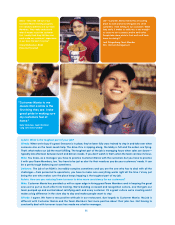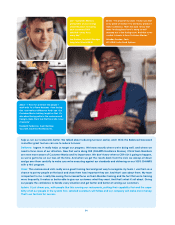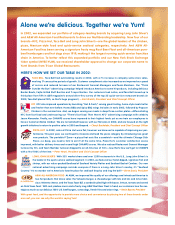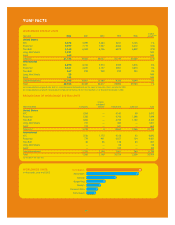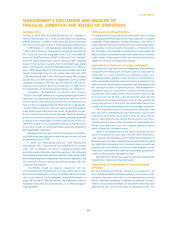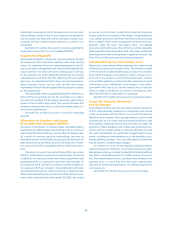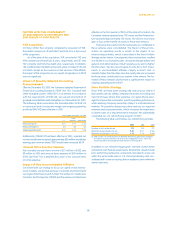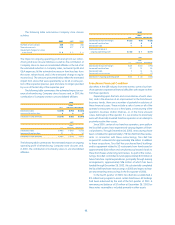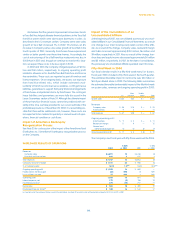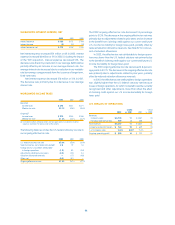Pizza Hut 2002 Annual Report Download - page 32
Download and view the complete annual report
Please find page 32 of the 2002 Pizza Hut annual report below. You can navigate through the pages in the report by either clicking on the pages listed below, or by using the keyword search tool below to find specific information within the annual report.
impairment measurement test for an investment in an unconsol-
idated affiliate is similar to that for our restaurants except that we
use discounted cash flows after interest and taxes instead of dis-
counted cash flows before interest and taxes as used for our
restaurants.
See Note 2 for a further discussion of our policy regarding the
impairment of investments in unconsolidated affiliates.
Impairment of Goodwill
We evaluate goodwill for impairment on an annual basis through
the comparison of fair value of our reporting units to their carrying
values. Our reporting units are our operating segments in the U.S.
and our business management units internationally (typically indi-
vidual countries). Fair value is the price a willing buyer would pay
for the reporting unit, and is generally estimated by discounting
expected future cash flows from the reporting units over twenty
years plus an expected terminal value. We limit assumptions
about important factors such as sales growth and margin
improvement to those that are supportable based upon our plans
for the reporting unit.
We impaired $5 million of goodwill during 2002 related to our
Pizza Hut France reporting unit. For the remainder of our report-
ing units with goodwill, the fair value is generally significantly in
excess of the recorded carrying value. Thus, we do not believe that
we have material goodwill that is at risk to be impaired given cur-
rent business performance.
See Note 2 for a further discussion of our policies regarding
goodwill.
Allowances for Franchise and License
Receivables and Contingent Liabilities
We reserve a franchisee’s or licensee’s entire receivable balance
based upon pre-defined aging criteria and upon the occurrence of
other events that indicate that we may not collect the balance due.
As a result of reserving using this methodology, we have an
immaterial amount of receivables that are past due that have not
been reserved for at December 28, 2002. See Note 2 for a further
discussion of our policies regarding franchise and license opera-
tions.
Primarily as a result of our refranchising efforts, we remain
liable for certain lease assignments and guarantees. We record
a liability for our exposure under these lease assignments and
guarantees when such exposure is probable and estimable. At
December 28, 2002, we have recorded an immaterial liability for
our exposure which we consider to be probable and estimable.
The potential total exposure under such leases is significant, with
$278 million representing the present value of the minimum pay-
ments of the assigned leases at December 28, 2002, discounted
at our pre-tax cost of debt. Current franchisees are the primary
lessees under the vast majority of these leases. We generally have
cross-default provisions with these franchisees that would put
them in default of their franchise agreement in the event of non-
payment under the lease. We believe these cross-default
provisions significantly reduce the risk that we will be required to
make payments under these leases and, historically, we have not
been required to make such payments in significant amounts. See
Note 24 for a further discussion of our lease guarantees.
Self-Insured Property and Casualty Losses
We record our best estimate of the remaining cost to settle incurred
self-insured property and casualty claims. The estimate is based
on the results of an independent actuarial study and considers
historical claim frequency and severity as well as changes in fac-
tors such as our business environment, benefit levels, medical
costs and the regulatory environment that could impact overall
self-insurance costs. Additionally, a risk margin to cover unfore-
seen events that may occur over the several years it takes for
claims to settle is included in our reserve, increasing our confi-
dence level that the recorded reserve is adequate.
See Note 24 for a further discussion of our insurance programs.
Income Tax Valuation Allowances
and Tax Reserves
At December 28, 2002, we have recorded a valuation allowance
of $137 million primarily to reduce our net operating loss and tax
credit carryforwards of $176 million to an amount that will more
likely than not be realized. These net operating loss and tax credit
carryforwards exist in many state and foreign jurisdictions and
have varying carryforward periods and restrictions on usage. The
estimation of future taxable income in these state and foreign juris-
dictions and our resulting ability to utilize net operating loss and
tax credit carryforwards can significantly change based on future
events, including our determinations as to the feasibility of cer-
tain tax planning strategies. Thus, recorded valuation allowances
may be subject to material future changes.
As a matter of course, we are regularly audited by federal,
state and foreign tax authorities. We provide reserves for poten-
tial exposures when we consider it probable that a taxing authority
may take a sustainable position on a matter contrary to our posi-
tion. We evaluate these reserves, including interest thereon, on a
quarterly basis to insure that they have been appropriately
adjusted for events that may impact our ultimate payment for
such exposures.
See Note 22 for a further discussion of our income taxes.
30.




